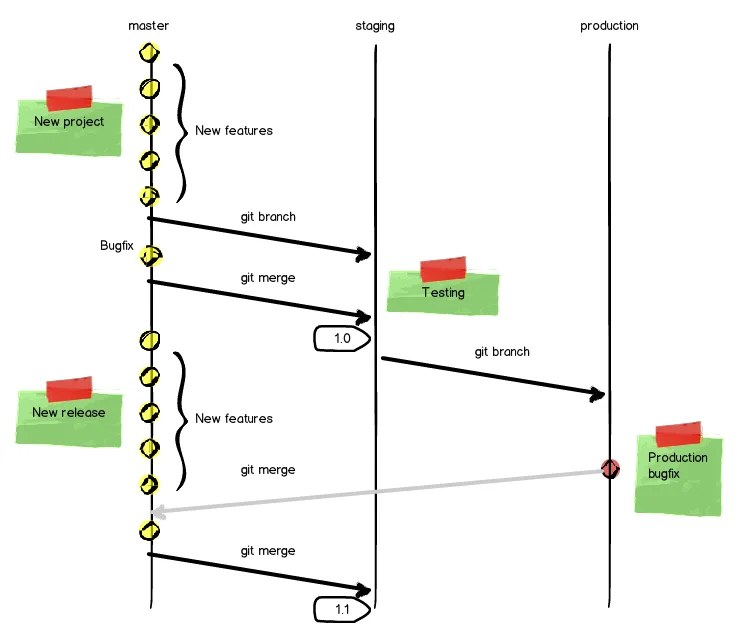Development happens on the master branch. Commit as often as you want, then push the changes to the repository, fetch it on the development server and test it. Once finished with development, switch to the sandbox branch in the local or development environment, merge the changes in from the master and push them. Update the staging site. hand over the project to the customer so that he can test and provide feedback, which needs to be implemented in the master branch. Repeat this step as often as necessary.

Once everything has been tested, merge the staging branch into production on the dev or staging environment and push the changes. It is important to do this step not on the production server because it could result in a merge conflict (e.g. when there were bugfix commits on the production branch, see below). Resolving them first and ensuring a fast-forward merge on the production server helps to keep the downtime as low as possible.
Below are detailed descriptions for the mentioned cases in the image.
Releasing a new project
Make sure you have the most recent code.
git checkout master
git pull
Create a new branch called staging
git checkout -b staging
Push branch and set upstream
git push -u origin staging
Now switch to the staging server and clone the project using the staging branch.
git clone --branch staging [email protected]:web-example-com/web.git
Then set up as usual. Replace staging with production for the production workflow.
Alternatively, if the server is already using git, you need to switch to the branch. As always, make sure there are no local chances. If there are, clean them up.
git status
Fetch the most recent code from the repository and checkout/switch to the production branch.
git fetch
git checkout production #(Git 1.7 +)
git checkout -b production origin/production (older git versions)
New feature
Make sure you are on the master branch and have the most recent code.
git pull
git status
Develop, once finished:
git status
Look through your changes, make there aren't any obvious errors.
git diff
Commit to master branch and push.
git commit -a -m "Meaningful commit message, refs #123" (#issue number in chiliproject)
git push
Check out on development server, test. then merge into staging branch to prepare the customer handover. Make sure to switch back to the master branch locally immediately, to avoid accidental commits on the wrong branch.
git checkout staging
git merge master
git push
git checkout master
Then update using git pull.
Production bugfix
It is sometimes necessary to fix an urgent bug in the production code while you have a large amount of new changes in the master branch. This is the only case where working directly on the production branch is allowed. Make sure you have no pending changes # git status
Switch to production branch and make sure you have the most recent code.
git checkout production
git pull
Fix bug, then commit
git commit -a -m "Description, fixes #333"
git checkout master
Switch to production branch on staging/testing environment. If development has schema changes, a db restore might be necessary
git checkout production
git pull
Verify that bug is fixed, then git pull on production and merge changes into master branch.
git checkout master
git merge production
Alternatively, you can also pick a single commit from a production branch and add it to the current branch.